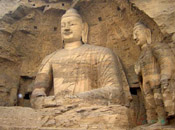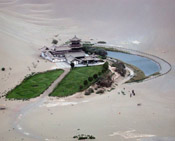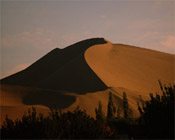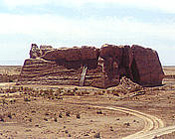|
Dunhuang
Dunhuang is located in the west of Hexi Corridor of Gansu province of China. It was made a prefecture in 117B.C. by Emperor Han Wudi, and was a major point of interchange between China and the outside world during the Han and Tang dynasties.
Throughout Dunhuang's history of over two thousand years, it has always served as a critical gateway to the west because of its unique geographical location at the juncture of Gansu, Qinghai and Xinjiang. As a result, several emperors throughout Chinese history have made improvements of these western fortifications.
However, Dunhuang was also a regional cultural center. The Mogao Grottoes, also known as the Dunhuang Grottoes or the "Thousand Buddha Grottoes", is located on the western cliffs of the Singing Sands Mountains. It is one of the most complete collections of Buddhist frescoes and sculpture from a period ranging over ten dynasties.
Recommended China Tours Including Dunhuang:


|
Tourist Hihglights
|
| |
 |
Mogao Caves
The Mogao Caves, a shrine of Buddhist art treasures, also known as the Thousand Buddha Caves, constitute one of the three major Buddhist grotto sites in China, 25 km (15.5miles) from downtown Dunhuang on the eastern slope of Mingsha Shan (Mount Echoing Sand). A network of plank reinforced roads plying north to south 1600 meters (5, 249 feet) long lead to the cave openings, which are stacked five stories high some reaching up to 50 meters (164 feet). By the way, Mogao means high up in the desert.
The construction of the Mogao Grottoes spanned more than a thousand years ranging from the Early Qin, Northern Wei, Western Wei, Northern Zhou, Sui, Tang, Five Dynasties, Song, Xixia and Yuan.
In 1989, the United Nation listed Mogao Grottoes as one of the cultural relics under special protection. In 1991, the UNESCO gave a formal testimonial to the Chinese government as to list the grottoes as a " worldwide cultural heritage ". In the same year, it was also valued by the National Tourism Administration as one of the "forty best scenic spots across the country ". |
 |
|
The Crescent Lake
Just as oil and water don't mix, so do springs and deserts. But Crescent Spring is an exception. About 6 kilometers (3.73 miles) south of Dunhuang city, and surrounded by the Echoing-Sand Mountain, Crescent Spring can be called a natural wonder in the Gobi Desert. The Spring's name derives from the crescent moon shape the small pool of spring water has taken between two large sand dunes. Although the area is very dry, the pool doesn't dry up as one might expect.
Here you can enjoy not only the rare view where an oasis meets the desert, but also some fun sand adventures, such as riding camels, "dune surfing" sand sliding. After climbing to the top of the dunes, from there you can't help but marvel at the dramatic view. You have discovered the wondrous sight of Crescent Spring!
Mingsha Mountain
Dunhuang has a spectacular natural scene: Mingsha (Sighing) Sand Dune. The dune, a sand crusted hill of dozens of meters high, is 40km east to west, and 20km south to north. When people slide from the hill, they hear the sighing of the sand. Hence the name.
|
 |
 |
|
Dunhuang Museum
Located at Yangguan East Road in Dunhuang City, Dunhuang Museum was established in 1979. It was previously the location of an archaeological group of the county culture centre (Dunhuang City was a county as that time). The museum focuses on historic cultural relics. Its construction area is 2400 square meters. The present cultural relics housed in the museum are more than 4000 pieces. |
|
|
Yangguan Pass
Yangguan Pass, one of China’s two most important western passes, is a mountain pass that was fortified in Western Han Dyansty and used as an outpost in ancient China. It is located 70 km southwest of Dunhuang and named for its location south to Yumen Pass. It was established as a frontier defense post, as well as a developed place in China’s remote western frontier. Nowadays, the ancient Yangguan City is replaced by the Yangguan Remains. There’s endless desert named “Antique Beach” behind the pass, where spreads ancient coins, weapons, decorations and potsherds. It is a must visit site in Silk Road, the thing matters is not the beauty but the history and story behind the remains.
|
|
White Horse Pagoba (Bai Ma Ta)
The White Horse Pagoda (baima ta) was originally built in 386 AD. Legend has it that some 1350 years ago, a prominent monk was riding to japan to spread Beddhism. On route, his horse dropped dead at Dunhaung. He was so disconsolate that he buried the horse and built a pagoda in memory of it. After numerous renovations, this nine-story, 12-meter-tall and sevem-meter-in-diameter pagoda has become one of the major tourist magnets in Dunhuang. |
|
 |
The Yumen Guan Pass & The Yang Guan Pass
Once the Yumen Guan Pass was one of the west gates out of the country of the Han Dynasty (206 B. C.-220 A. D.), it is quite ruined by the shifting sands but still shows the ever splendor. The Yang Guan Pass was also one of the west gates out of the country of the Han Dynasty.
The Hecang Fortress
Supplies like food and wine were transported here from nearby towns to be stored for the armies that guarded the Yumen Guan Pass. |
Recommended China Tours Including Dunhuang:


|
|
| Other City |
|
|
 |
| Private China Tours |
|
|
 |
|

